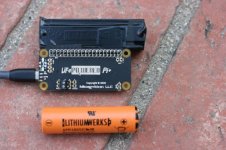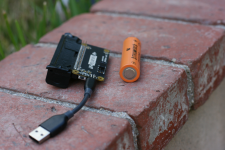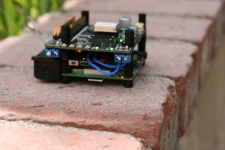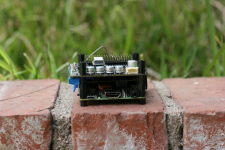@roderickvd
5V tolerant was refer to signal's logic level. Not the voltage of power supply.
The advantage of using 3.3V power supply is that it can use super clean 3.3V passive power supply (ultracapacitor or LifePO4) directly to avoid any active LDO.
Regards,
Ian
5V tolerant was refer to signal's logic level. Not the voltage of power supply.
The advantage of using 3.3V power supply is that it can use super clean 3.3V passive power supply (ultracapacitor or LifePO4) directly to avoid any active LDO.
Regards,
Ian
I know it's hard to grasp a portable Q3. Here's some photos to get a better idea.
I'm using a LiFePO4 BMS + A123 18650 battery + RPi 3A+.
The soldered terminal on the BMS is for 3.3V. The Q3 gets 5V via GPIO.
You can see the solid core silver from the side. It doesn't stick out and stays within the Q3 parameters.
The TransportPi (not shown) has only HDMI and TOSLINK. The others are removed. It's minimalist.
If this was my only Q3 build, I would be more than happy. Especially with RCP added. But it looks like I'm going FiFo desktop too.
My first attempt used 5 pairs of solid core wires and a A123 26650 battery. It got too bulky and complicated, so I settled for simple. This build just one pair of wire as shown.
With a 1TB microSD full album WAV redbook, I can just throw the Q3 in my loose shorts and a Chord DAC is my fitness belt connected via glass optical cable and control via IR remote. I just use bedside for now, but after pandemic will take it outside for walkabouts. I can also control via iPhone via hotspot on 3A+.
I'm using a LiFePO4 BMS + A123 18650 battery + RPi 3A+.
The soldered terminal on the BMS is for 3.3V. The Q3 gets 5V via GPIO.
You can see the solid core silver from the side. It doesn't stick out and stays within the Q3 parameters.
The TransportPi (not shown) has only HDMI and TOSLINK. The others are removed. It's minimalist.
If this was my only Q3 build, I would be more than happy. Especially with RCP added. But it looks like I'm going FiFo desktop too.
My first attempt used 5 pairs of solid core wires and a A123 26650 battery. It got too bulky and complicated, so I settled for simple. This build just one pair of wire as shown.
With a 1TB microSD full album WAV redbook, I can just throw the Q3 in my loose shorts and a Chord DAC is my fitness belt connected via glass optical cable and control via IR remote. I just use bedside for now, but after pandemic will take it outside for walkabouts. I can also control via iPhone via hotspot on 3A+.
Attachments
Last edited:
@A123
It's a really good idea to move the FifoPi Q3 power connectors that way. Very smart idea!
Ian
It's a really good idea to move the FifoPi Q3 power connectors that way. Very smart idea!
Ian
@roderickvd
5V tolerant was refer to signal's logic level. Not the voltage of power supply.
The advantage of using 3.3V power supply is that it can use super clean 3.3V passive power supply (ultracapacitor or LifePO4) directly to avoid any active LDO.
Regards,
Ian
not completely 5Volt compliant though:
The interface between 5V CMOS and 3.3 V LVTTL parts illustrates a lack of voltage tolerance; the LVTTL IC input is overdriven by the 5 V CMOS device output. The interface between the 2.5 V JEDEC and the 5 V CMOS part demonstrates a lack of voltage compliance; the output high level of the JEDEC IC does not comply to the input level requirement of a the 5 V CMOS device.
Meaning, if your input logic level is like close to 5V it will not work. I had this with the WaveIO and lowered Vcc to 4 Volt to make it work
That’s too bad. Though I still may step down to 3.3V sometime using
A) a voltage divider
B) an LDO
C) a separate PSU
I thought cascading LDO’s was a fine strategy for improving PSRR at every step?
I realize that batteries beat active PSU’s but I think the price point is extremely steep. Never say never but for now I like my LT3045 and AMB s22 PSU’s.
A) a voltage divider
B) an LDO
C) a separate PSU
I thought cascading LDO’s was a fine strategy for improving PSRR at every step?
I realize that batteries beat active PSU’s but I think the price point is extremely steep. Never say never but for now I like my LT3045 and AMB s22 PSU’s.
@A123
It's a really good idea to move the FifoPi Q3 power connectors that way. Very smart idea!
Ian
Hello Ian,
Your print offers the possibility to do the soldering on both sides of the circuit board?
If you are not planning to take them apart 3 times every year why not use a nice quality solid core wiring that will fit nicely into the hole designed to take the soldering pin of the terminal?
If the circuit you are feeding has some kind of state of the art low voltage drop regulator right next to the load it can only be useful if the input voltage is higher than the output voltage and the lifepo4 / supercap combo is at a 30 cm/ 1 foot distance or more.. If not skip the regulator?
Greetings,Eduard
Just had a thought. I've fitted the Andrea Mori clock adaptor board onto the Fifo...with all 4 pins. Don't I need to remove the power pin as the Mori clock has an external psu.?
Just had a thought. I've fitted the Andrea Mori clock adaptor board onto the Fifo...with all 4 pins. Don't I need to remove the power pin as the Mori clock has an external psu.?
The power pin is not used in the TWTMC-DIL, so you can keep it in place for better mechanical stability.
Yes sorry I just realised the pin is there for mechanical stability and electrically NC....silly me.!
Please see the attached picture for how to upgrade a FifoPi with a ReClockPi.
Only need one u.fl cable to connect MCLK signal from FifoPi to ReclockPi. That's very simple.
By default, FifoPi shares the clean side 3.3V with ReClockPi. But can be upgraded to separated 3.3V power supplies at any time.
BTW, under the FifoPi is a RaspberryPi Zero (without WIFI). Less than $10-. Doing a good job. I like it.
https://flic.kr/p/2kTYtBp
ReclockPiFifoPi by Ian, on Flickr
Ian
Hi Ian - If the Pi zero is without WiFi how are you connecting the Pi to the Internet/network as I dont see an ethernet connector?
Last edited:
@SimonJ
You will need a USB Ethernet adapter to connect RPi Zero to a wired network.
https://www.amazon.ca/Plugable-Ethe...9Y2xpY2tSZWRpcmVjdCZkb05vdExvZ0NsaWNrPXRydWU=
Ian
You will need a USB Ethernet adapter to connect RPi Zero to a wired network.
https://www.amazon.ca/Plugable-Ethe...9Y2xpY2tSZWRpcmVjdCZkb05vdExvZ0NsaWNrPXRydWU=
Ian
How do I stop the Rpi music signal from auto playing. ?
For instance I have Spotify being cast to moode Rpi. If I even pause Spotify then the last radio station from moode kicks in. I thought I read in one of Ians manuals about this but don't seem to recall now. Id like to turn it off if possible!
For instance I have Spotify being cast to moode Rpi. If I even pause Spotify then the last radio station from moode kicks in. I thought I read in one of Ians manuals about this but don't seem to recall now. Id like to turn it off if possible!
This is configurable behavior in moOde, please look under audio settings. I don't think it has anything to do with hardware.
StationPi Pro
Got the StationPi Pro PCB samples this week. Started to test and debug.
StationPi Pro has a touch screen controller. This controller can take care of everything. The controller also has a build in FifoPi controller. I think a lot of people are waiting for this feature.
Touch screen size can be 2.4", 2.8" or 3.2". Controller software will be open source so that the GUI and layout can be customized.
When working with ReceiverPi MKII, StationPi is capable of up to five inputs, RPi, OPT, RCA, HDMI and USB. It can be used to set up a very professional streamer/DAC.
StationPi Pro will be in all finished. Mounting screw positions will be compatible with the original StationPi.

StationPiProRD by Ian, on Flickr

StationPiProDisplay by Ian, on Flickr
Got the StationPi Pro PCB samples this week. Started to test and debug.
StationPi Pro has a touch screen controller. This controller can take care of everything. The controller also has a build in FifoPi controller. I think a lot of people are waiting for this feature.
Touch screen size can be 2.4", 2.8" or 3.2". Controller software will be open source so that the GUI and layout can be customized.
When working with ReceiverPi MKII, StationPi is capable of up to five inputs, RPi, OPT, RCA, HDMI and USB. It can be used to set up a very professional streamer/DAC.
StationPi Pro will be in all finished. Mounting screw positions will be compatible with the original StationPi.

StationPiProRD by Ian, on Flickr

StationPiProDisplay by Ian, on Flickr
Last edited:
Nice. I'm ordering a Combo384 soon, so JIT. I'm a month away from an order.
I was able to get in on the last of Andrea's finished board and clock so that's 1-2 months.
StationPiPro
ReClockPi
LPS Solo
I was able to get in on the last of Andrea's finished board and clock so that's 1-2 months.
StationPiPro
ReClockPi
LPS Solo
D
Deleted member 537459
@SimonJ
You will need a USB Ethernet adapter to connect RPi Zero to a wired network.
https://www.amazon.ca/Plugable-Ethe...9Y2xpY2tSZWRpcmVjdCZkb05vdExvZ0NsaWNrPXRydWU=
Ian
for me ethernet via usb is deleterious, in fact the raspberry 4 sounds better than the rpi3.
...raspberry 4 sounds better than the rpi3.....
I am still confused on claims like this. The FiFoPi should make this transparent.
my experience is, that I cannot seriously hear any difference between a RP3 and a WaveIO connected to the RP3 USB port with both feeding the FiFoPi
I have not tried to compare with RP4, so no idea "how much better" this would or could be?
imho most things we do are not as "significant" as we would like it to be.
@Ian, did you do some serious comparison between the RP versions with your FiFoPi?
I am still confused on claims like this. The FiFoPi should make this transparent.
my experience is, that I cannot seriously hear any difference between a RP3 and a WaveIO connected to the RP3 USB port with both feeding the FiFoPi
I have not tried to compare with RP4, so no idea "how much better" this would or could be?
imho most things we do are not as "significant" as we would like it to be.
@Ian, did you do some serious comparison between the RP versions with your FiFoPi?
- Home
- Source & Line
- Digital Line Level
- Asynchronous I2S FIFO project, an ultimate weapon to fight the jitter




